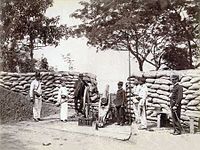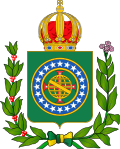Revolta da Armada
This article may require cleanup to meet Wikipedia's quality standards. (January 2012) |
| Brazilian Naval Revolt | |||||||
|---|---|---|---|---|---|---|---|
| Part of Federalist Revolution | |||||||
 A Brazilian battery at Rio de Janeiro in 1894. | |||||||
| |||||||
| Belligerents | |||||||
|
Support: |
| ||||||
| Commanders and leaders | |||||||
|
|
| ||||||
| Strength | |||||||
|
10 forts (Army control) Loyalist Navy Squad: 2 cruisers 1 torpedo-boat destroyer 6 torpedo boats 2 monitors 4 auxiliary cruisers 2 gunboats |
1 fort (navy mutineers control) Mutineers Navy Squad: 2 coastal battleships 4 cruisers 2 monitor 1 gunboat 7 torpedo boats 9 auxiliary cruisers[1] | ||||||
| Casualties and losses | |||||||
|
4 ship sunk Several fortifications destroyed or severely damaged |
12 ship sunk Large | ||||||
The Brazilian Naval Revolts, or the Revoltas da Armada (in Portuguese), were armed mutinies promoted mainly by Admirals Custódio José de Melo and Saldanha Da Gama and their fleet of Brazilian Navy ships against the claimed unconstitutional staying in power of the central government in Rio de Janeiro.[2]
First revolt[]

In November 1891, President Marshal Deodoro da Fonseca, amid a political crisis compounded by the effects of an economic crisis, in flagrant violation of the new constitution, decided to "solve" the political crisis by ordering the closure of Congress, supported mainly by Paulista oligarchy. The Navy, still resentful of the circumstances and outcomes of the coup that had put an end to the monarchy in Brazil,[3] under the leadership of Admiral Custódio José de Melo, rose up and threatened to bombard the town of Rio de Janeiro, then capital of the Republic. To avoid a civil war, Marshal Deodoro resigned the presidency in 23 November.[4] With the resignation of Deodoro, after just nine months from the beginning of his administration, the vice president, Floriano Peixoto, took office (1892). The 1891 Constitution, however, provided for a new election if the presidency or vice-presidency became vacant sooner than two years in office. The opposition then accused Floriano of staying as head of the nation illegally.
Second revolt[]
The second revolt started in March 1892, when thirteen generals sent a letter and manifesto to the President Marshal Floriano Peixoto. This document demanded new elections be called to fulfill the constitutional provision and ensure internal tranquility in the nation. Floriano harshly suppressed the movement, ordering the arrest of their leaders. Thus, not legally solved, the political tensions increased. The revolt broke out in September 1893 at Rio de Janeiro, and was suppressed only in March 1894 after a long blockade of the city.
With many of the Brazilian Navy's most powerful ships either in the hands of the rebels or under repair, the Brazilian government had to improvise a new fleet to battle the rebel fleet. The "cardboard squadron" had to face off against a mutiny that had overtaken most of the powerful ships of the original navy. Local bloody conflicts in some regions of Brazil ensued. The navy's mutiny off Rio de Janeiro (Guanabara Bay) also was a challenge, and became linked to the Federalist Rebellion.

The revolt included the powerful battleship Aquidaban and a collection of small ironclads, modern cruisers and older wood 'cruiser' or steam frigate type ships. Two of the navy's major ships were overseas and supposedly away from the conflict: the battleship Riachuelo was under repairs in France, and the corvette Barrozo was on a round-the world training voyage (during which she sank). This did not leave the government with much left to challenge the mutineers, who could have controlled the seas and influenced the concurrent conflicts on land. The government basically bought itself a new naval force on the open markets, of small and sometimes unusual ships including torpedo gunboats, various medium and small torpedo boats, small armed yachts, and a transport converted to carry a Zalinsky "dynamite gun" (a pneumatic gun launching a dynamite charge of massive explosive force and marginal accuracy). Such improvised stocking up was common at that time: the US pressed a similar mix of ships into action to supplement its fleet in the 1898 war with Spain (or to buy them before Spain could), and Japan also scrambled to purchase available ships for its conflict with Russia in 1904-5. In this case, however, the new fleet was dedicated to confronting the original navy of the same country.[5]
Details of conflict[]
On 13 September, the fortresses in Rio de Janeiro, held by the Army, began to be bombarded.[6] The rebel forces' fleet consisted of navy vessels and civilian vessels of Brazilian and foreign companies.[citation needed]
In the Navy, the rebels were the majority, but faced strong opposition in the Army, where thousands of young people joined the battalions that supported President Floriano. State elites, especially Sao Paulo, were also in favor of Floriano.[citation needed]
At dawn on 1 December, Custódio de Mello, in Aquidabã, followed by the República and auxiliary cruisers, went south to join the federalists.[7] At the time was the Federalist Revolution, a dispute between the federalists (maragatos) and republicans (woodpeckers), the latter supported by Floriano. The Federalists The city of Desterro, as it was then called the capital of Santa Catarina, was dominated by the rebels.[citation needed]

On 7 December, Rear Admiral Luis Filipe Saldanha da Gama (1846 - 1895), then director of the Naval School, joined the movement, taking over the rebels in Rio de Janeiro, beginning the second phase of the Armada Revolt. By this time, the rebels had little ammunition and no food. The São José Fortress, on Cobras Island, was practically destroyed by the loyalist troops and, on 9 February 1894, when the rebels, under the command of Saldanha da Gama, landed at Ponta da Armação, in Niterói, were defeated. They were also defeated on Governor's Island.[8]
Niterói, which was the capital of the state of Rio de Janeiro, had its seven bombed forts. On 20 February 1894, the seat of government was then moved to Petrópolis, a mountain town beyond the reach of the Navy guns. Niterói would not return to host the capital in 1903.[citation needed]
The federal government had acquired warships, which were dubbed the "cardboard fleet." The command of this squadron was given to Admiral Jerônimo Gonçalves (1835 - 1903), veteran of the Paraguayan War. In March 1894, with the support of the Army and the Paulista Republican Party (PRP), the Armada Revolt was stifled.[9] The rebels took refuge in the Portuguese ships Mindelo and Afonso de Albuquerque, ending the second phase of the revolt.[citation needed]
The Federalist Revolution continued in the south, where Saldanha da Gama and his men were led. Custódio de Mello had taken the port of Paranaguá and was united with the federalist leader Gumercindo Saraiva (1852 - 1894). They took the city of Lapa and the government troops moved south. On 16 April 1894, the battleship Aquidabã of the rebels was torpedoed in Santa Catarina by the torpedo Gustavo Sampaio, commanded by Lieutenant Altino Flavio de Miranda Correia.[10]
In the República cruiser, Custódio de Mello, commanding four merchant ships and two thousand men, unsuccessfully tried to land in the city of Rio Grande. It was defeated by the troops of the government of Julio de Castilhos. The navy revolutionaries were defeated. Custódio took refuge in Argentina, where he delivered the ships.[11] According to historian Helio Silva, the end of the third and final phase of the Armada Revolt happened with the death of Saldanha da Gama, on 25 June 1895, in Campo Osório, Rio Grande do Sul.[12][13]
Photo gallery[]

Rebel battleship Aquidaban bombarding the forts of Rio de Janeiro (drawing of Fouqueray, according to a photography, published in Le Monde Illustré, nº 1.916, 1893.).

Fort Villegaignon, in possession of the rebel forces: the sinking vessel is the monitorJavary.

Fortress of Villegaignon after bombing of the loyalists Squad in Battle of Guanabara Bay.

Image of prisoners taken during the Revolta da Armada (Navy Revolt) in Brazil (1893 - 1894).

Army infantry and artillery troops defending the port area of Rio de Janeiro.

Fortress of Laje after being bombed by the revolting ships.
Main ships involved in the conflict[]
Rebel Squad[]


- Battleship Aquidabã - Seriously damaged (disabled until the end of the conflict) by torpedo attack in combat against destroyer Gustavo de Sampaio in Battle of Anhatomirim.
- Battleship Sete de Setembro - Sunk and burned during the Battle of Guanabara Bay.
- Protected Cruiser Tamandaré
- Protected Cruiser República
- Cruiser Trajano
- Gunboat Marajó - Sunk after fire during the Battle of Guanabara Bay.
- Monitor Alagoas
- Monitor Javary - Sunk by coastal artillery (Fortress São João) during the Battle of Guanabara Bay.
- Torpedoboat Marcílio Dias
- Torpedoboat Iguatemi
- Torpedoboat Araguari
- Auxiliary cruiser Pereira da Cunha - Sunk by coastal artillery (Fort Gragoatá) after explosion of its ammunition stockpile, killing all crew, Battle of Ponta da Armação (Niterói).
- Transport Ship Madeira - Sunk by coastal artillery (Fort Gragoatá) during the Battle of Ponta da Armação (Niterói).
- Transport Ship Palas - Sunk after collision with a rock in Battle of Anhatomirim.
Loyalist Squad[]
- Cruiser Tiradentes
- Cruiser Parnaiba
- Destroyer Gustavo Sampaio
- Monitor Solimões
- Gunboat Cananéia - Sunk by rebel Cruiser República in combat, southern Brazil.
- Gunboat Piratini - Sunk in combat against Rebel Squad in Salvador, Bahia.
- Auxiliary cruiser Nichteroy
- Torpedoboat Pedro Ivo
- Torpedoboat Pedro Affonso
- Torpedoboat Silvado
- Torpedoboat Bento Gonçalves - Seriously damaged in combat against the rebel battleship Aquidabã in Battle of Anhatomirim.
- Torpedoboat Sabino Vieira
- Torpedoboat Tamborim
- Transport ship Itaipu
See also[]
- Brazilian Navy
- First Battle of Topolobampo
- Rebellions and revolutions in Brazil
References[]
- ^ Brassey, Thomas Allnutt "The Naval Annual; 1894" Elibron Classics/Adamant Media Corporation 2006, Chapter XI "The Naval Revolt in Brazil"
- ^ Smith, Joseph "Brazil and the United States; convergence and divergence" University of Georgia Press 2010, page 39
- ^ Smallman; Shall C. Fear & Memory in the Brazilian Army & Society, 1889–1954 The University of North Carolina Press 2002 ISBN 0807853593 Page 20 2nd paragraph
- ^ Joseph Smith; Brazil and the United States: Convergence and Divergence University of Georgia Press 2010, page 38, 2nd paragraph
- ^ "Archived copy". Archived from the original on 19 February 2011. Retrieved 15 December 2011.CS1 maint: archived copy as title (link)
- ^ Gazeta de Notícias, 14 September 1893, under the title "The Revolt"
- ^ O Paiz, 2 December 1893, under the title "The Revolt"
- ^ Gazeta de Notícias, 10 February 1894, under the title "The Revolt"
- ^ The Paiz, 14 March 1894 and Gazeta de Notícias, 16 March 1894
- ^ Gazeta de Notícias, 18 April 1894, under the title "A Revolt"
- ^ Diário de Notícias, 23 April 1894
- ^ Gazeta de Notícias, 26 June 1895
- ^ http://brasilianafotografica.bn.br/?p=2375
External Links[]
- Military history of Brazil
- Naval mutinies
- 1893 in Brazil
- 1894 in Brazil
- Blockades
- Rebellions in Brazil







